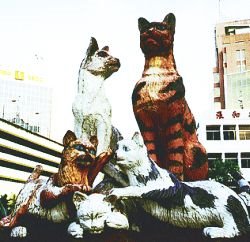Picture by and Copyright to PAMELA PHANG KOOI YOONG/The Star
By Pamela Phang Kooi Yoong
"There are lots of museums.” That is what everyone said when they heard we were going to Kuching, Sarawak. They were not wrong; there are no less than seven museums in the city.
“Kuching” means “cat” in Malay. As the city has adopted the feline as its emblem, you will find giant cat statues decorating roundabouts and even a Cat Museum that is a fount of information on cats.
A cat’s nine lives is explained as a derivative of the Egyptian view of the nine elements of oneself. There are exhibits on the many different cats including the Leopard cat, Marble cat, Clouded leopard, Bay cat and civets.
The role of cats in Malaysian society is also touched on.
The Malays believe that it is lucky to keep cats because cats are fond of soft cushions to lie on and so they indirectly wish for their masters to prosper.
The Chinese deem the coming of a strange cat into one’s house to be unlucky, a harbinger of impending poverty.
All the same, in the old days in China, the silk industry needed cats as guards against rats and mice which ate silkworm larvae and their cocoons.
This is a catty museum, all right. Everything related to cats are broached: the reason for cat fights, cat superstitions, the caring and holding of cats. There are also old movie posters relating to felines.
Did you know that they believe the first cat rhyme known to man is probably The Cat and the Fiddle?
The Sarawak Museum meanwhile is an immense white building of blue window sills atop a green hillock. Built in 1891 by Charles Brooke, the building is a copy of the town hall in Normandy in France. The design dates back to the time of Queen Anne.
The exhibits mostly concern the handicrafts of the people of Sarawak – the Ibans, Bidayuh, Kelabit, Penan etc. Their dances, ceremonies, musical instruments, weapons, bamboo and wood products are displayed with interesting explanations.
I liked the outdoor Garden Museum adjacent to the Sarawak Museum. There are magnificent raintrees and garden benches for one to relax here.
The Memorial Tower, with its broad steps, was built in memory of the constabulary and the Malaysian, Briitish and Commonwealth armed forces, as well as civilians who lost their lives in wars past.
Each side of the tower bears the face of a hero, for example, Liu Shanbang who attacked and chased Raja James Brooke out of Astana.
A collection of ornate Chinese tombstones is scattered at the foot of the tower. It would seem the Chinese played a prominent role in f Kuching’s history.
Charles Vyner Brooke, the White Rajah of Sarawak, was sufficiently satisfied as to wish the Chinese managed their own affairs, from marriages and divorce, to division of properties. The Chinese Chamber of Commerce of old has today become the Chinese History Museum.
This small, squarish white building of uncomplicated design is essentially a single large hall with polished wood panel flooring and ceiling.
Turned into a museum in 1993, it aims to preserve the hardships and struggles of the pioneering Chinese more than 150 years ago. Almost all the dialects are represented here.
It was commonly held that it was the ambition of every Chinese emigrant to return to his homeland after seeking his fortune abroad.
But this, as you will learn here, more often than not was merely a dream. A Fujien saying has it that out of every 10 people who went abroad, three died, six remained and only one returned.
The Hakkas were the early gold miners, the Hokkiens traders and shopkeepers, the Cantonese artisans and skilled labourers etc.
The individual stories of the early pioneers are also recounted, among them, Lau Chek ( a Cantonese), Ong Ewe Hai (a Hokkien), Liew Sha Peng (a Hakka) etc. Among the exhibits are old photos, wooden chests and cabinets, old porcelain vases and antique furniture.
The other museums in the city are the Timber Museum, Textile Museum, Islamic Museum, Pua Khumbu Museum (traditional cloth craft of the indigenous people) and Costume Museum. W
Addresses
Cat Museum
Kuching North City Hall
Jalan Semariang
o Opens daily from 9am-5pm, but closed on the first day of major festivals. Free entrance.
Sarawak Museum
Jalan Tun Abang Haji Openg
o Opens daily from 9am-5.30pm, closed on the first day of major festivals. Free entrance.
Chinese Museum
Main Bazaar Road
(near the Tua Pek Kong’ temple)
o Opens daily, closed on the first day of major festivals. Free entrance.
Sarawak Islamic Museum
o Opens daily, except on Friday, from 9am-5.30pm. Free entrance.
Pua Kumbu Museum
4th Floor, Tun Jugah Tower
o Open Monday to Friday, closed on Saturday, Sunday and public holidays. Free entrance.
Timber Museum
Wisma Sumber Alam, Petra Jaya
o Open Monday to Saturday, closed on Sunday and public holidays. Free entrance.
Source: The Star, Travel & Adventure

No comments:
Post a Comment